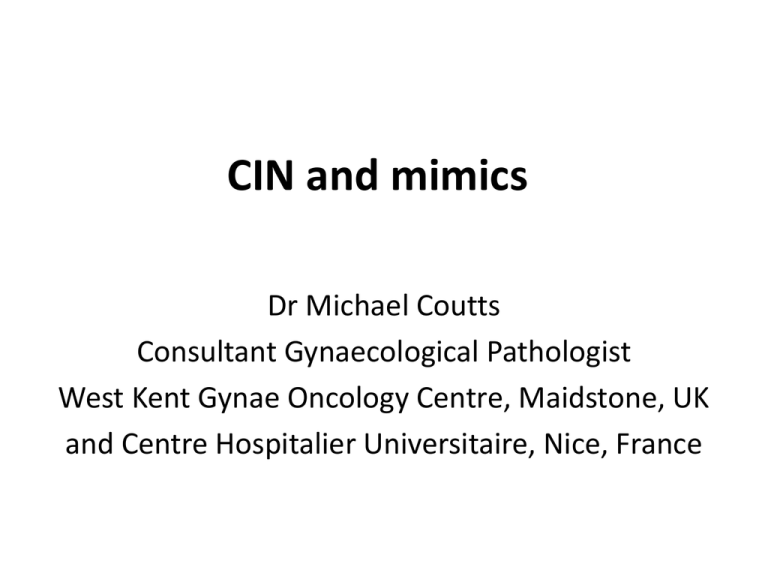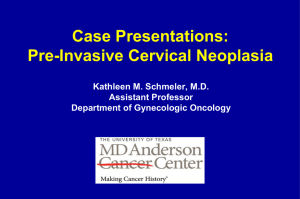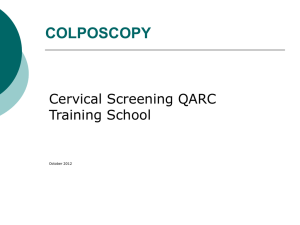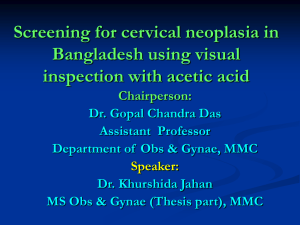Mimics of CIN
advertisement

CIN and mimics Dr Michael Coutts Consultant Gynaecological Pathologist West Kent Gynae Oncology Centre, Maidstone, UK and Centre Hospitalier Universitaire, Nice, France Cervical intraepithelial neoplasia (CIN) • Abnormal proliferation, nuclear atypia and lack of maturation of squamous cells within the epithelium Natural history of CIN • • • • Conflicting data from various studies, however: 90% of CIN 1 regresses in 2 years 50% of CIN 2 regresses in 2 years Approx 10% of CIN 1 and 20% of CIN 2 will progress to CIN 3 • Approx 30% of CIN 3 will regress but roughly 20% will progress to invasive squamous ca • Mean time for progression from CIN to invasive cancer approx 10 – 20 years Human papillomavirus (HPV) • Present in 99.7% of cervical cancer • A causative agent for virtually all cervical cancer (and CIN and CGIN/ACIS) • 55nm non-enveloped DNA virus Human papillomavirus • Over 100 sub-types according to gene sequence of L1 capsid protein • Highest risk 16, 18, 31, 45 • HPV 16 and 18 together cause 70% of cervical cancer • HPV infection starts at TZ (squamocolumnar junction) • Most HPV infection is cleared by the immune system but a minority progresses to CIN or invasive carcinoma • Factors influencing progression include HPV type, viral load, host immunity, parity, smoking, oral contraceptives <10% Infection with HPV 15-25 yrs >90% Lesions Asymptomatic infection Koilocytosis and CIN 1 Most 20% CIN 2 Elimination of virus 20% Regression of lesions ? Appx 30% regression of CIN2/3 Effective immune system CIN 3 20% progression If untreated Invasive carcinoma Normal cervix CIN 1 (LSIL) • Nuclear atypia with mitoses and a high N:C ratio confined to the lower 1/3 • Koilocytosis most obvious in the upper levels of epithelium Koilocytosis • Perinuclear clearing which is sharply defined • Eccentric, hyperchromatic nucleus with coarse chromatin • Nuclei may be multinucleate or raisinshaped Koilocytosis without CIN (LSIL) Condyloma acuminatum • Benign papilloma caused by HPV • Usually low risk 6, 11 • More common on vulva • Cauliflower-like growth of fibrovascular cores lined by squamous mucosa with koilocytosis, parakeratosis • Essentially LSIL, but occasionally high grade CIN may occur in a condyloma CIN 2 (HSIL) • Nuclear atypia with failure of maturation and mitoses in lower 2/3 • Abnormal mitoses may be seen • Koilocytosis in upper layers CIN 3 (HSIL) • Nuclear atypia with failure of maturation in upper 1/3 • Abnormal mitoses • Koilocytes hard to find • No invasion CIN 3 CIN 3 CIN 3 in endocervical crypt Keratinising CIN 3 Pleomorphic CIN 3 Immunohistochemistry in CIN 3 Ki67 p16 Mimics of CIN: Immature metaplasia • Stratified layers of cells with little maturation (a high N:C ratio) which may extend into crypts But: • Nuclei evenly spaced, without much crowding • Regular nuclear outline, without coarse chromatin • Low mitotic rate, without abnormal forms • Layer of residual endocervical epithelium may be present on the surface (rare over high grade CIN) Mimics of CIN: Immature squamous metaplasia Mimics of CIN: Immature metaplasia Immunohistochemistry of immature squamous metaplasia Ki67 p16 Mimics of CIN: Atrophy • Stratified layer of cells with little maturation (ie with a high N:C ratio) But: • Epithelium is thin • Nuclei are evenly spaced, without crowding • Nuclear pleomorphism and mitoses are absent • Nuclei may be ovoid with longitudinal grooves (socalled ‘transitional metaplasia’, probably a variant of atrophy) Mimics of CIN: Atrophy Mimics of CIN: Atrophy and inflammation Mimics of CIN: Reactive, inflammatory changes • Inflammation can cause nuclear enlargement, nucleolar prominence and scattered mitotic figures But: • Pleomorphism is mild and N:C ratio generally normal • Mitoses are few and only in lower layers • Nucleolar prominence is not a typical feature of CIN • Acute and chronic inflammatory cells are present in the epithelium together with intercellular oedema • Mild perinuclear clearing of squamous cells may be seen as an inflammatory phenomenon Mimics of CIN: Inflammation (with atrophy and tangential sectioning) Mimics of CIN: inflammation Inflamed CIN 3 Mimics of CIN: diathermy artefact • Artefact in surface epithelium adjacent to resection margins due to heat from the loop • Nuclear hyperchromasia and elongation • Changes most marked in the basal layers with the overlying surface epithelium often normal • Mitoses not identified • Adjacent epithelium often normal • Low immunohistochemical staining with Ki67 Mimics of CIN: Diathermy artefact Mimics of CIN: tangential sectioning • Poor orientation of the biopsy during paraffin embedding so that the histological section is not 90° to the epithelial surface • The basal layer is sectioned obliquely so that it appears thicker than normal and gives a false impression of lack of maturation • However, cellular spacing is generally even, without crowding • Deeper levels cut from the block may clarify the overall architecture of the lesion Mimics of CIN: tangential sectioning Mimics of CIN: tangential sectioning Tangential sectioning (deeper levels) Conclusions • HPV infection is common but only a minority progresses to CIN or invasive carcinoma • This progression is slow and so CIN can be detected by screening before invasion occurs • CIN is graded 1 to 3 • Mimics of CIN include immature squamous metaplasia, atrophy, inflammation, diathermy artefact, tangential sectioning









